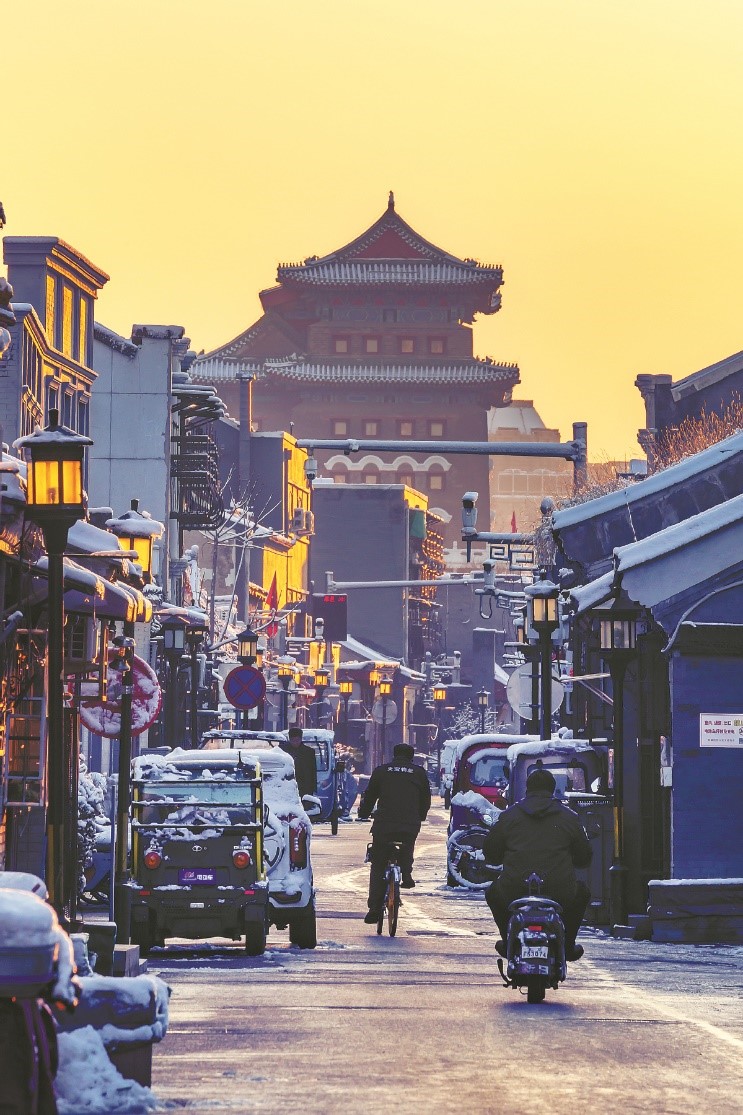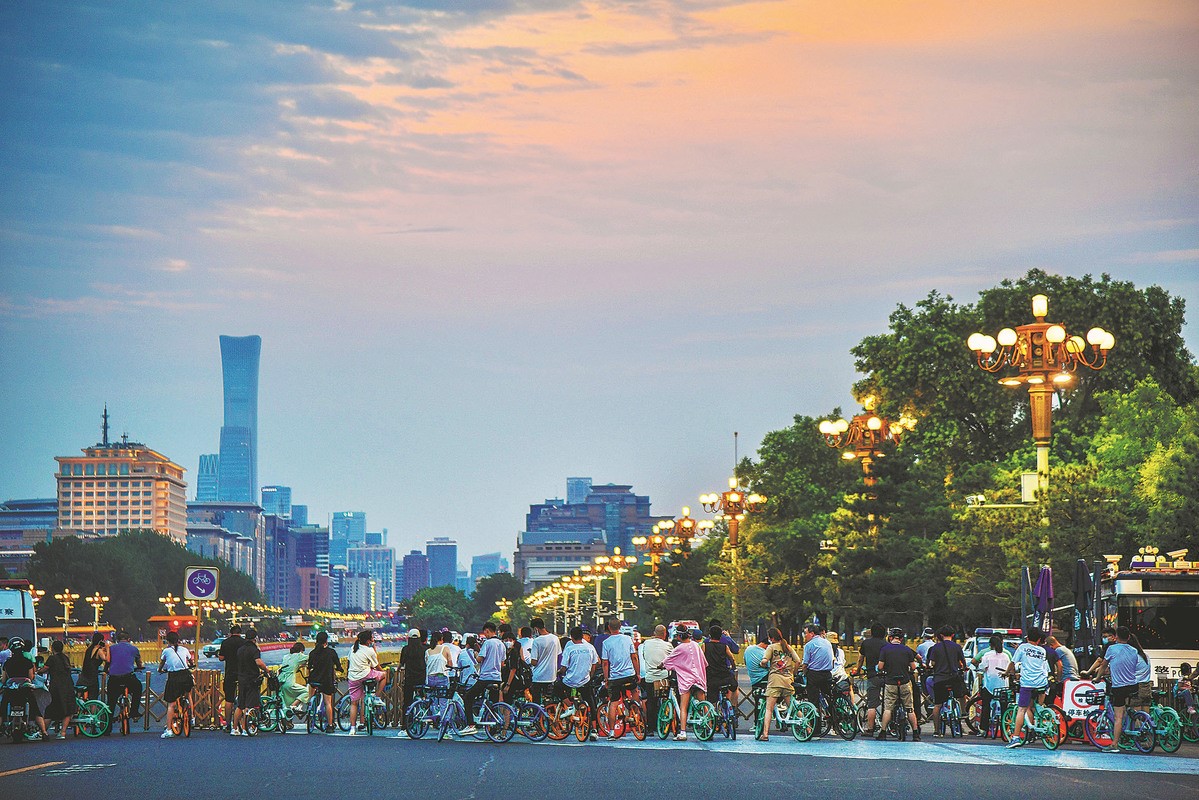



A cyclist and an electric bike rider travel along a hutong in the Qianmen area of Beijing after snow falls on the morning of March 19. [ZHAO DI/FOR CHINA DAILY]
More designated lanes make life easier for urban riders
Crowds of customers gather on Huguosi Street in Beijing's Xicheng district on a sunny winter afternoon, lining up outside snack shops in the ancient alleyway for a taste of flaky pastries or toasted soybean rice cakes. A group of cyclists wearing colored helmets stands out among the patrons. The riders had stopped to grab a bite to eat on their way to completing a 40-kilometer tour of the city.
Zhao Lu, 30, a white-collar worker in the Chinese capital who is a keen cyclist, said, "It's not easy for an office worker like me to come here for the street food, as the journey takes time. "A few weeks ago, I saw a promotion on a social media platform for a pastry shop on this street, but I never got the chance to taste the food. However, by cycling to the store for exercise, I can buy the food I want." Zhao said such a situation is common in Beijing, as the city's myriad hutong, or alleyways, require nonmotorized forms of transportation for convenient access. "The alleyways used to be full of parked cars, and there wasn't enough space for people such as myself to stop and buy goods," she said.
Traffic congestion, which has long plagued Beijing, stems in part from the rising number of cars in the city. As part of efforts to address this problem, the municipal government announced a plan last year to develop slower forms of transportation to build a pedestrian- and bicycle-friendly city by 2035. By the end of October, 21 themed cycling routes with a total length of 730.8 kilometers had been introduced by the Beijing Culture and Tourism Bureau. These routes have four cross-district cycle lanes connecting the city's major scenic spots, and 16 such lanes featuring tourist attractions in each district.
Riders using the routes enjoy the scenery while benefiting from exercise. Liu Daizong, China sustainable cities program director at the World Resources Institute, or WRI, said the new cycle routes have helped the city establish a more inclusive and diverse culture. "Beijing is a large urban city with distinct neighborhoods where diverse lifestyles coexist. It is good to use alternative modes of transportation, because in many places attractive views of the city cannot be seen from a car traveling at speed. On the other hand, cyclists proceeding more slowly are able to enjoy what the city has to offer," Liu said. While the cycle lanes require investment and human resources to maintain them, they are cost-effective in terms of promoting green living.

Cyclists wait for traffic lights to change at a crossing on Chang'an Avenue, Beijing, at sunset on July 19. [CHINA DAILY]
Link introduced
In 2018, the authorities in Beijing began to build the city's first cycles-only road in the north of the capital, connecting the densely populated Huilongguan community with the Shangdi area, home to a cluster of high-tech companies. The 6.5-kilometer route has been used frequently since it opened on May 31, 2019, and according to the Beijing Municipal Commission of Transport, the road had seen more than 5.24 million rides as of June.
Liu, from the WRI, who is a member of the Beijing Transport Commission's expert committee that assesses the city's transportation projects, said authorities have promoted the return of bicycles in the capital since 2018. "Many of the projects I reviewed before 2018 involved retrofitting traffic lights, and building parking lots and intelligent transportation systems. But since 2018, most of the projects I have assessed have been related to bicycles," Liu said.
In May, the Beijing municipal government announced a transportation development and construction plan, which aims to introduce designated cycle lanes on all roads with a width of 12 meters or more within the Fifth Ring Road in the next three years. Some 400 km of waterfront slow-traffic lanes will also be launched by 2025.
Yang Xinmiao, associate researcher at Tsinghua University's Institute of Traffic Engineering and Geospatial Information, said: "This is an inspiring goal. To achieve it, the safety and continuity of the designated cycle lanes should be given priority when planning roads. "We need to be clear about the use of these cycle lanes," said Yang, who has long been involved with research work on green transportation and traffic safety, and also cycles to and from work. "Safe space should be provided for cyclists on the lanes. If they feel safe, they will continue to use the lanes, but they may be discouraged if the lanes are not connected or end suddenly at a crossroads." In 2021, some 52 km of nonmotorized transportation improvements were made to Beijing's Second Ring Road, with the width of the cycle lanes being increased from 2 meters to more than 3 meters, said Yang, who took part in this work. "Traffic efficiency rose by 25 percent after the improvements, and the accident rate was reduced, as the wider lanes saw drivers slow down to prevent the risk of an accident," Yang added. "The improvements made to the Second Ring Road set a good example for other busy roads in the city outside the downtown area that still need designated cycle lanes."
Waiting time
Along with the additional cycling infrastructure in Beijing, public demand for cycling has risen, as evidenced by soaring bike sales during the COVID-19 pandemic. Hu Zhigang, a cycling coach and sales manager at Specialized Bicycle in Chaoyang district, sensed the increased demand for bicycles after the pandemic emerged. "Sales of bikes were sluggish before the pandemic, and we had many cycles in stock, but since 2021, all the bikes in our store have been sold, and it's now extremely difficult to get one, as demand has risen so sharply," Hu said. "The waiting time for a bike can now be as long as a year, as factories are unable to keep pace with the growing demand from customers."
Two popular bicycle brands - Giant and Phoenix - are in particular demand. According to Giant Group, one of the world's largest bicycle manufacturing and marketing companies, its sales volume in March 2021 reached 18 billion yuan ($2.6 billion), year-on-year growth of 17 percent. Phoenix Bicycle, a time-honored domestic brand based in Shanghai, saw its revenue reach 2.05 billion yuan in 2021, a rise of nearly 50 percent from 2020, which was also a record high. According to the Beijing Transport Institute, the number of annual cycle rides in the capital, including those on shared bikes, rose to 950 million in 2021, up from 50 million in 2017. In 2021, the proportion of nonmotorized transportation in the central urban area of the city reached 47.8 percent, a record high for the past 10 years, according to the Beijing Transport Commission.
He Ying, 38, a business owner and mother of two in the city, who bought a Specialized bike in April, said it gives her more freedom to explore places she wanted to visit before the pandemic struck. "I now have more places to visit, but I wouldn't consider many of them were it not for my bike. I can take it to the Liangma River with my kids to get some food, or I can ride alongside the Grand Canal to Tongzhou district. I can leave the bike pretty much wherever I want, and don't have to bother about parking places," He said. "This is a healthier alternative to using a car, and when I bought the bike, I was motivated to get outside more often."
Second phase
Liu, from the WRI, said cycling has regained popularity in many countries during the pandemic. He said cities such as Paris and London have launched a number of bicycle-related activities designed to promote physical exercise. In recent years, more cycle lanes and related facilities have been added to streets in London. In Spain, the authorities in Barcelona have pioneered the new urban concept of superblocks, with access to motorized vehicles restricted in certain areas to make them greener and friendlier for walking and cycling.
Liu said, "A typical hutong in Beijing is about the same length as one of these superblocks in Barcelona. These narrow alleys are also not suitable for cars. If we keep motor vehicles out of such neighborhoods, we can regain a sense of the past in Beijing. "People can ride their bikes in the morning to buy crusty Chinese pancakes, sound their cycle bells in a hutong, and greet their neighbors - reflecting the traditional culture of Beijing." Installing the first bicycles-only road in Beijing is the first step for the city to raise cycling's profile and make people aware that the activity is returning, Liu said. "We are now in the second phase of developing the culture of cycling to improve safety for riders, which requires more streets to be redesigned and for joint efforts from numerous municipal departments," he added. "As a result, people will have increased confidence in riding bikes when they know they have a safe space and dedicated infrastructure to provide a good experience."
Edited by Wang Miao
with reference to <https://global.chinadaily.com.cn/a/202302/08/WS63e2daeba31057c47ebad793_1.html>